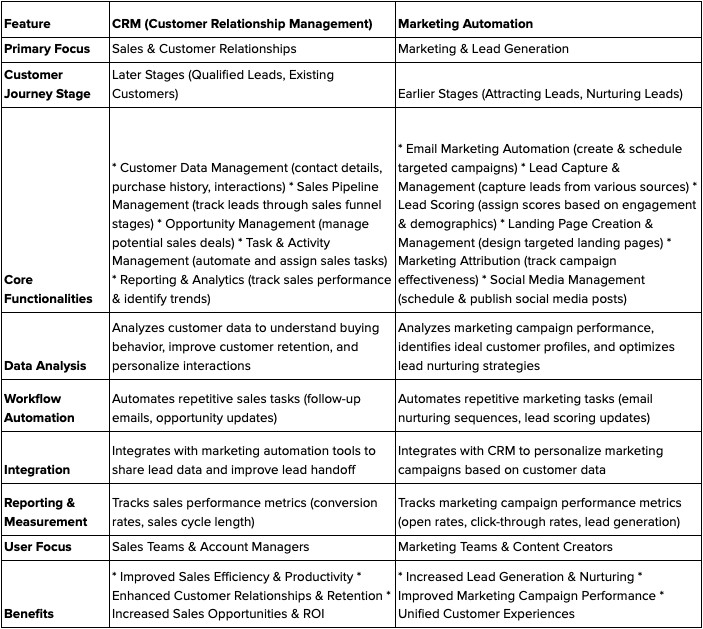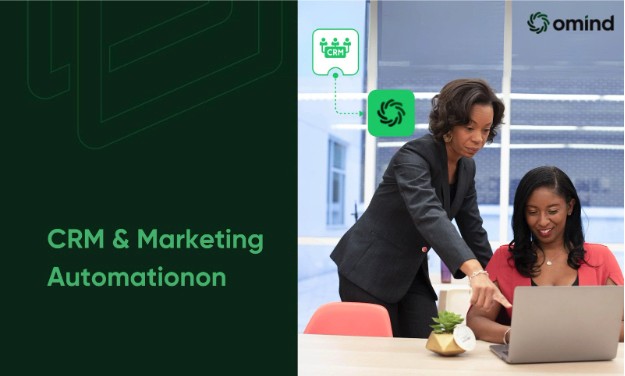Jul 5, 2024
BLOG • 4 MIN READ
Integration of CRM and Marketing Automation
Travel, Hospitality & Transport
Customer relationship management (CRM) and marketing automation are two essential tools in the modern sales and marketing toolkit. While distinct in their functionalities, they can make for a powerful ecosystem for your marketing team’s productivity. This article explores CRM and marketing automation, their individual strengths, and the significant benefits gained through their strategic integration.
What Is CRM?
CRM stands for customer relationship management. A CRM is typically a software solution designed to centralize and manage all customer interactions and data. In essence, CRM acts as a comprehensive customer information hub. It stores contact details, purchase history, communication records, and other relevant data points. Having centralized information gives sales teams the ability to build stronger relationships with customers, personalize interactions, and streamline the sales process for every transaction.
Modern CRMs offer additional functionalities like:
Automated Sales Workflows: CRMs can automate repetitive tasks like lead assignments, follow-up emails, and opportunity tracking.
Sales Pipeline Management: A CRM can help visualize sales progress by tracking leads through different stages of the sales funnel.
Reporting and Analytics: Generate customizable reports to gain insights into sales performance, identify trends, and measure campaign effectiveness.
There are several benefits to using a CRM. Here are a few for your reference.
Efficient Management of Customer Data: Maintain a single source of truth for all customer information, ensuring data accuracy and accessibility.
Enhanced Customer Service: Gain a thorough understanding of customer needs and preferences, enabling personalized interactions and improved customer satisfaction.
Increased Sales Opportunities and ROI: Streamlined processes and data-driven insights allow sales teams to close more deals and maximize return on investment.
What Is Marketing Automation?

Marketing automation software takes some of the CRM functionalities several steps further: It basically takes care of a team’s repetitive marketing tasks, allowing marketers to focus on strategic initiatives. It plays a crucial role in lead generation, nurturing, and campaign management. Key components of marketing automation include:
Email Marketing Automation: Create and schedule targeted email campaigns, personalized with customer data for increased engagement.
Lead Scoring: Assign scores to leads based on their interactions and demographics, allowing for prioritization and segmentation.
Landing Page Creation and Management: Design and deploy targeted landing pages to capture leads and nurture them through the sales funnel.
Marketing automation platforms like Omind offer a range of functionalities to automate tasks and personalize marketing efforts.
Here are some of the benefits of using marketing automation:
Increased Efficiency and Time Savings: Automate repetitive tasks, freeing up time for strategic marketing activities.
Profitability and Productivity Boost: Streamlined workflows and targeted campaigns lead to improved campaign performance and return on investment.
Improved Customer Satisfaction: Personalized and relevant interactions throughout the customer journey make for a unified customer experience and loyalty.
CRM vs. Marketing Automation: Key Differences
While CRM and marketing automation share a common goal of driving customer acquisition and retention, they differ in their primary focus areas and workflow. We have made a table with the differences, for easy reference.

Can A CRM and Marketing Automation Be Integrated?

The answer is yes: Integrating CRM and marketing automation gives you the best of both solutions. What results is an end-to-end sales and marketing ecosystem, offering several significant advantages:
Enhanced Visibility: Both sales and marketing teams gain a holistic view of the customer journey. Sales reps can see how leads interact with marketing campaigns, and marketers can track lead conversion rates.
Shortened Sales Cycle: Streamlined lead handover from marketing to sales reduces the time it takes to close deals.
Consistent Messaging: Integrated platforms ensure consistent communication across all touchpoints and a more unified customer experience.
Integrating CRM and marketing automation can also present some challenges.
Compatibility Issues: Choosing compatible software from the outset is crucial for seamless data flow.
Data Silos: Inconsistent data entry practices can create data silos, hindering the effectiveness of integration.
Process Alignment: Sales and marketing teams need to align their strategies and processes to ensure smooth lead handoff.
Best Practices for CRM and Marketing Automation Integration

To reap the full benefits of CRM and marketing automation, consider these best practices.
Choosing the Right Software: Select compatible CRM and marketing automation platforms that can integrate seamlessly and scale alongside your business needs.
Aligning Strategies: Ensure sales and marketing teams work collaboratively to develop aligned strategies. Consistent messaging and lead nurturing processes are critical for success.
Setting Measurable Goals and Tracking Performance: Define clear goals for the integrated system, such as increased lead conversion rates or improved customer retention. Regularly track KPIs to measure progress and identify areas for improvement.
The Future of CRM and Marketing Automation
The future of CRM and marketing automation is heading in an interesting direction, with the advent of AI-powered solutions. These can now analyze vast amounts of customer data, providing even deeper insights into customer behavior and preferences. Additionally, the rise of mobile solutions will create even more touchpoints for customer interaction, necessitating a unified and integrated approach to managing customer data and interactions across all channels.
If you’d like a helping hand when it comes to marketing automation, Omind is your answer. Omind leverages AI to bring to you a conversational platform that helps visitors engage with your business and turns visitors into paying customers. To see how our platform works, schedule a demo at this link today.
AUTHOR
Team Omind
Empowering Businesses with Unified Customer Experience Platform, Leveraging Advanced AI and Intelligent Automation
PRODUCT
Arya AI
Share LINK
Related Blogs






